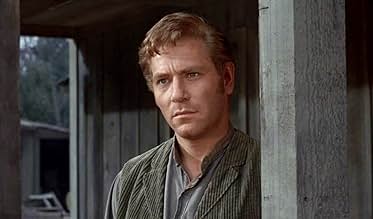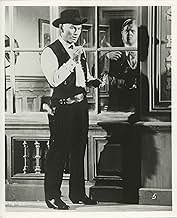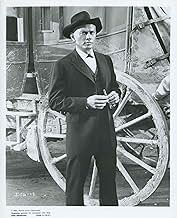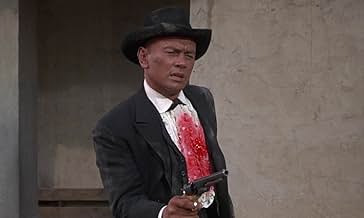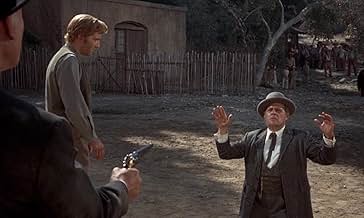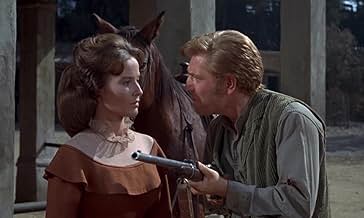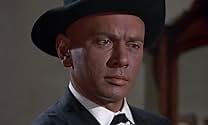Adicionar um enredo no seu idiomaIn New Mexico, a Confederate veteran returns home to find his fiancée married to a Union soldier, his Yankee neighbors rallied against him and his property sold by the local banker who then ... Ler tudoIn New Mexico, a Confederate veteran returns home to find his fiancée married to a Union soldier, his Yankee neighbors rallied against him and his property sold by the local banker who then hires a gunman to kill him.In New Mexico, a Confederate veteran returns home to find his fiancée married to a Union soldier, his Yankee neighbors rallied against him and his property sold by the local banker who then hires a gunman to kill him.
- Direção
- Roteiristas
- Artistas
- Manuel
- (as John Alonzo)
Avaliações em destaque
A confederate solider Matt Weaver returns back to his small town after the civil war to find out his home has been sold by the dominating town boss Sam Brewster. Causing a ruckus, Brewster hires the interestingly mysterious gunfighter Jules Gaspard d'Estaing to take care of Brewster; however Jules gets caught up in the devious shades of a town run by corrupt figures.
The way the story pans out is thoughtfully projected and the framework delivers it in an unconventional manner with some psychological interplays. The way the steely protagonist uses the situation to gain what he wants and hand out much needed justice within the shameful town simply holds you there. It's literally chatty, but never does it outstay its welcome. A sternly defined Brynner is outstanding (as the camera magnetically follows him around) and likewise is a booming Hingle. When the action/shoot outs occur they're rather sparse, but toughly staged despite its obvious studio bound sets.
AS the movie progresses it's slowly revealed that the Union leaning town is not what it seems to be. Pat Hingle plays a politician very common for 30 years after the Civil War, adept at what they called "waving the bloody shirt." Just demagogue away at who did what and where during the war and ignore the current issues both social and economic.
During the course of The Magnificent Seven, Yul Brynner's Chris Adams is referred to as a Cajun. Here he's given a proper Cajun name of Jules D'Estaing and when his secret is revealed, a whole lot of people in that town have to confront their own prejudices.
Makes for worthwhile viewing.
This talky, awe-inspiringly pretentious 'adult' western (scripted by Wilson and his wife Elizabeth) that a few years earlier would have signalled it's seriousness by being in black & white (like 'High Noon' or '3:10 to Yuma') is instead shot in incongruously pretty colour by veteran cameraman Joe MacDonald on the Universal backlot, where Brynner later trashes the already flimsy-looking sets with suspicious ease.
Based on a 1957 TV play, it was made too early to be influenced by Sergio Leone, but was obviously influenced (as was Leone himself) by the samurai films of Kurosawa.
The cast was largely recruited from TV and the New York stage, some of whom - like George Segal and Strother Martin - became more familiar a few more years later; while David Raksin's woodwind score lingers in the memory.
Nattily dressed in a black suit and a ruffled white shirt, Jules is the strong, silent type, equally adept at playing poker, reciting poetry, and playing the harpsichord as he is engaging in "work and play" with his guns. He is well paid to finish the job but soon discovers that his prospective victim may be more honest than those who are joined against him. Although he makes the statement that he is no longer human, Jules' actions prove otherwise as he develops a sympathy for Weaver, becomes attracted to Ruth, and finds aid and comfort with the Mexicans in the village who have been shunted to the outskirts of town by the corrupt bosses. When Jules, seething with frustration, goes on a drunken rampage and nearly destroys the town single handedly, Sam makes a truce with Matt to get rid of the mysterious stranger and the showdown is set.
Yul Brynner turns in a compelling performance as the son of a slave who wants justice more than another payday. While there is a tendency in many films to glorify murderers for hire, we can relate to Jules more as a flawed human being with a troubled past than as a cold-blooded killer. Unfortunately the other characters are not as well developed and George Segal seems miscast as the vengeful war veteran. Janice Rule is lovely but is given little to do except stand around and look pensive. The less said about the musical score the better. Suffice to say, it did not add to the pleasure of watching this film. Being a Yul Brynner fan, however, I found Invitation to a Gunfighter a satisfying experience, a film whose themes of racism and interracial love were advanced, even for 1964 when consciousness about civil rights was exploding.
The acting is all over the board in this one, as well. Brynner's performance can't be faulted; he's his usual simmering, silent presence, but seems miscast in a role which could have been quite interesting if it weren't so poorly-written. Janice Rule seems confused in her role as Ruth Adams (and well she should be, forced to serve as the love interest between--count them--three men, all trying to kill each other at some point or another), and spends most of it looking vaguely sad and disinterested, and Pat Hingle is neither evil enough nor serious enough to make a compelling villain. Clifford David fares better as the perpetually angry Crane, and George Segal, as the unfortunate Matt Weaver, is just about the only member of the cast that seems to have any idea what he's doing. The rest of the townsfolk are a mixture of clichés and stereotypes that make it seem as though Yul Brynner mistakenly wandered onto the set of "Blazing Saddles." Brynner's presence, and the multi-layered, operatic scale of the plot might warrant repeat viewings, and the film should be credited for trying to tackle weighty issues of morality and racism, but ultimately "Gunfighter" misses its mark. The classic mantra in storytelling is "show, don't tell," and this film doesn't do that, rendering what should have been a very good movie into a very mediocre one.
Você sabia?
- CuriosidadesThe Psicose (1960) house set on the Universal back lot was the home for the character "Sam Brewster".
- Erros de gravaçãoOne of the Union infantry veterans in the town wears crossed rifles on his kepi. But the cross rifles insignia was not adopted for infantry until after the Civil War. The crossed rifles are what infantry wore during the post Civil War Indian wars. Rather, infantry wore a bugle on their kepis or bummers cap, and as the year is 1865 and as this is a Union infantry veteran from the Civil War, he should be wearing the bugle insignia and not the crossed rifles insignia.
- Citações
Sam Brewster: Is your name Jewel?
Hotel Owner: The hotel register....
Jules Gaspard d'Estaing: My name is
[d'Estaing writes his name on a blackboard]
Sam Brewster: Jewels...Gasperd...Die-es-ting
Jules Gaspard d'Estaing: Jules...soft j, silent s...Gaspard...silent d...d'Estaing...just a touch of dipthong.
- Cenas durante ou pós-créditosOpening credits prologue: NEW MEXICO TERRITORY - 1865
- ConexõesReferenced in Traído... Por uma Questão de Honra (1966)
Principais escolhas
- How long is Invitation to a Gunfighter?Fornecido pela Alexa
Detalhes
- Data de lançamento
- País de origem
- Idioma
- Também conhecido como
- Invitation to a Gunfighter
- Locações de filme
- Empresas de produção
- Consulte mais créditos da empresa na IMDbPro
Bilheteria
- Orçamento
- US$ 1.800.000 (estimativa)


